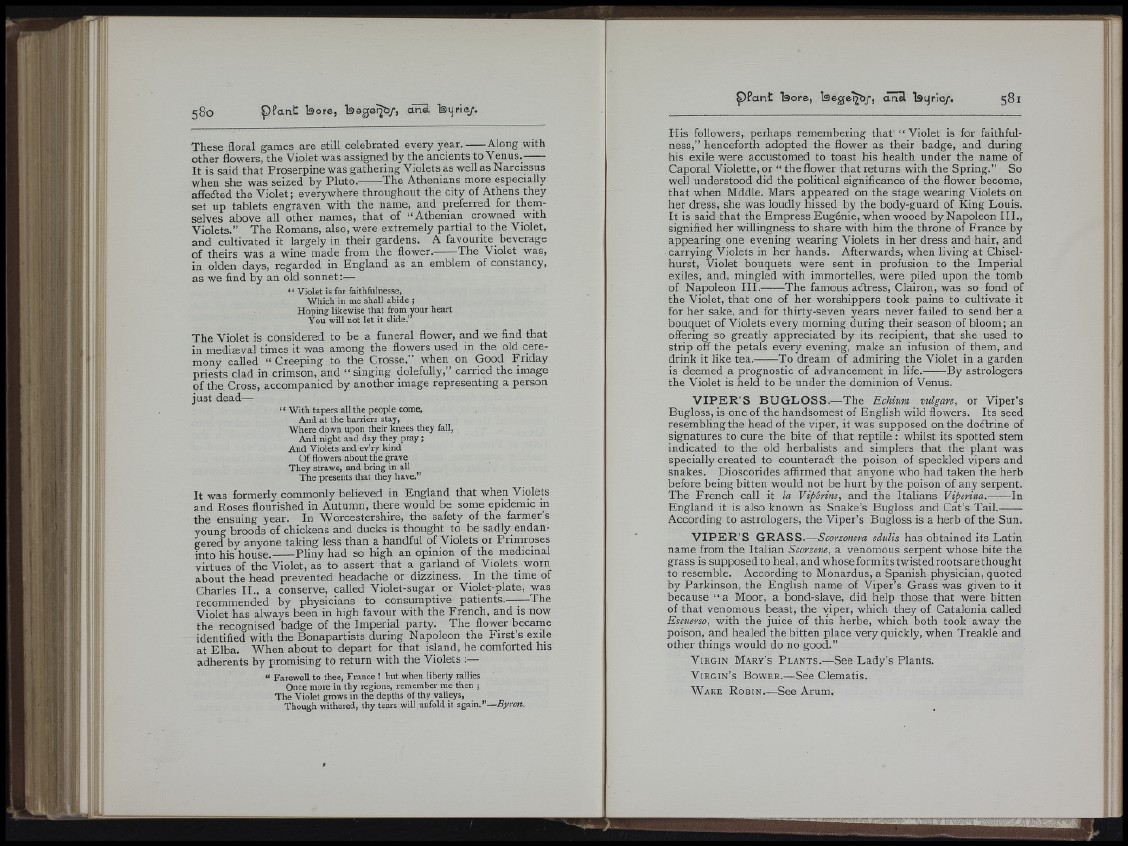
M
»
fill
These floral games are still celebrated every y e a r. Along with
other flowers, the Violet was assigned by the ancients to Venus.-----
It is said that Proserpine was gathering Violets as well as Narcissus
when she was seized by Pluto. The Athenians more especially
affeaed the Violet ; everywhere throughout the city of Athens they
set up tablets engraven with the name, and preferred for themselves
above all other names, that of “ Athenian crowned with
Violets.” The Romans, also, were extremely partial to the Violet,
and cultivated it largely in their gardens. A favourite beverage
of theirs was a wine made from the flower. The Violet was,
in olden days, regarded in England as an emblem of constancy,
as we find by an old sonnet :—
“ Violet is for faithfulnesse,
Which in me shall abide ;
Hoping likewise that from your heart
You will not let it slide.”
The Violet is considered to be a funeral flower, and we find that
in mediæval times it was among the flowers used in the old ceremony
called “ Creeping to the Crosse,” when on Good Friday
priests clad in crimson, and “ singing dolefully,” carried the image
of the Cross, accompanied by another image representing a person
just dead—
‘ ‘ With tapers all the people come,
And at the barriers stay,
Where down upon their knees they fall,
And night and day they pray ;
And Violets and ev’ry kind
Of flowers about the grave
They strawe, and bring in all
The presents that they have.”
It was formerly commonly believed in England that when Violets
and Roses flourished in Autumn, there would be some epidemic in
the ensuing year. In Worcestershire, the safety of the farmer s
young broods of chickens and ducks is thought to be sadly endangered
by anyone taking less than a handful of Violets or Primroses
into his house. Pliny had so high an opinion of the medicinal
virtues of the Violet, as to assert that a garland of Violets worn
about the head prevented headache or dizziness. In the time of
Charles II., a conserve, called Violet-sugar or Violet-plate, was
recommended by physicians to consumptive patients.——The
Violet has always been in high favour with the French, and is now
the recognised badge of the Imperial party. The flower became
identified with the Bonapartists during Napoleon the First’s exile
at Elba. When about to depart for that island, he comforted his
adherents by promising to return with the Violets :—
“ Farewell to thee, France ! but when liberty rallies
Once more in thy regions, remember me then ;
The Violet grows in the depths of thy valleys.
Though withered, thy tears will unfold it Byron.
His followers, perhaps remembering that “ Violet is for faithfulness,”
henceforth adopted the flower as their badge, and during
his exile were accustomed to toast his health under the name of
Caporal Violette, or “ the flower that returns with the Spring.” So
well understood did the political significance of the flower become,
that when Mddle. Mars appeared on the stage wearing Violets on
her dress, she was loudly hissed by the body-guard of King Louis.
It is said that the Empress Eugénie, when wooed by Napoleon HI.,
signified her willingness to share with him the throne of France by
appearing one evening wearing Violets in her dress and hair, and
carrying Violets in her hands. Afterwards, when living at Chisel-
hurst, Violet bouquets were sent in profusion to the Imperial
exiles, and, mingled with immortelles, were piled upon the tomb
of Napoleon H I. The famous acftress. Clairon, was so fond of
the Violet, that one of her worshippers took pains to cultivate it
for her sake, and for thirty-seven years never failed to send her a
bouquet of Violets every morning during their season of bloom; an
offering so greatly appreciated by its recipient, that she used to
strip off the petals every evening, make an infusion of them, and
drink it like tea. To dream of admiring the Violet in a garden
is deemed a prognostic of advancement in life. B y astrologers
the Violet is held to be under the dominion of Venus.
V IP E R ’S BUGLOSS.—The Echium vulgare, or Viper’s
Bugloss, is one of the handsomest of English wild flowers. Its seed
resembling the head of the viper, it was supposed on the doblrine of
signatures to cure the bite of that reptile : whilst its spotted stem
indicated to the old herbalists and simplers that the plant was
specially created to counteract the poison of speckled vipers and
snakes. Dioscorides affirmed that anyone who had taken the herb
before being bitten would not be hurt by the poison of any serpent.
The French call it la Vipérine, and the Italians Viperina. In
England it is also known as Snake’s Bugloss and Cat’s Tail.------
According to astrologers, the Viper’s Bugloss is a herb of the Sun.
V IP E R ’S GRASS.—Scorzonera edulis has obtained its Latin
name from the Italian Scorzone, a venomous serpent whose bite the
grass is supposed to heal, and whose form its twisted roots are thought
to resemble. According to Monardus, a Spanish physician, quoted
by Parkinson, the English name of Viper’s Grass was given to it
because “ a Moor, a bond-slave, did help those that were bitten
of that venomous beast, the viper, which they of Catalonia called
Escuerso, with the juice of this herbe, which both took away the
poison, and healed the bitten place very quickly, when Treakle and
other things would do no good.”
V i r g i n M a r y ’ s P l a n t s .— See L ad y ’s Plants.
V i r g i n ’ s B o w e r .— See Clematis.
W a k e R o b i n .— See Arum,